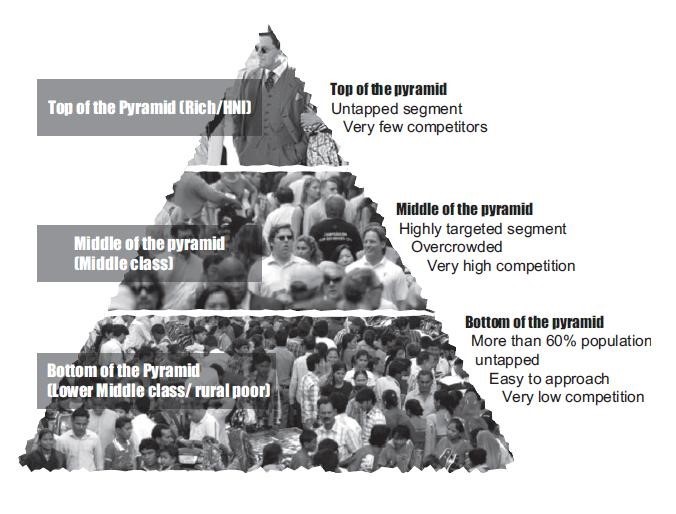C.K Prahalad posits that there is an immense fortune at the bottom of the pyramid. The Fortune at the Bottom of the Pyramid by C.K. Prahalad reframed the world’s poorest citizens as resilient and creative entrepreneurs and value-conscious consumers. He believed these consumers could be tapped to help create opportunities for economic growth.
Through strategic partnerships with those living at the base of the income pyramid, a win-win situation can be achieved. The situation would be sustainable, profitable, and solve societal and environmental problems in low-income nations. These low-income consumers represent more than 60% of the world’s population. Despite being generally ignored by marketers because of their small income, as a group, they made up a market potential in the trillions of dollars.
These 4 billion lower middle class and rural poor audiences have received far less attention from marketers and companies. This makes the group as a whole easier to approach with limited competition.
The Fortune at the Bottom of the Pyramid
 SOURCE: IIOE
SOURCE: IIOE
Sustainable and Scalable Business Models
It isn’t about exploiting low-income consumers. Instead, it’s’s about finding ways to work together to create solutions that benefit everyone. Innovating sustainable and scalable business models could cater to the needs of the world’s poor.
Multinational corporations, Prahalad wrote, have the potential to lift billions of people “out of poverty and desperation, averting the social decay, political chaos, terrorism, and environmental meltdown that is certain to continue if the gap between the rich and poor countries continues to widen.”
When the concept was introduced, it demonstrated how companies could innovate for the weakest markets, provide substantial-good, and attract consumers in developed companies as well. As people moved out of poverty, they become more active consumers.
The Bottom of the Pyramid Opportunities
Harvard Business Review researchers summarized some of the BoP opportunities represented by Prahalad’s’s theory:
Targeted Marketing Opportunity
BoP consumers may have knowledge gaps, which means they are underutilizing products. One example is cell phones and mobile devices. While attractive price points could be created, it required coaches to show villagers why these devices could improve their lives.
Product Design
Enhancing existing products to meet the specific needs of impoverished communities can lead to a larger overall market share and awareness. Pepsi introduced iron-fortified products to help adolescent girls in India that suffered from iron deficiencies. Nearly half of the country’s girls are iron-deficient. Violet Health recently launched iron-rich biscuits for India for the same reasons.
Expanding Distribution
Many consumers may be willing to buy products but have failed to have access to them. In rural areas that lack cold-storage facilities, for example, frozen dairy or juice products were all but unknown. Fan Milk created a generation of entrepreneurs by engaging residents to sell their products using refrigerated bicycles.
Product Development and Innovation
Taking into account the conditions and culture in poor rural communities and adapting consumer products has proven to be successful. In rural India, a third of the food is lost to spoilage. Godrej created a portable refrigerator using a cooling chip rather than a compressor. This dropped the cost dramatically and can run on batteries.
Unilever created a shampoo that works with cold water and is sold in small packages to make pricing affordable for low-income communities that may have limited access to hot water. Hindustan Unilever created tabletop and gravity-fed water purifiers to kill germs.
SC Johnson Company partnered with youth groups in Kenya. Together, they created community-based waste management and cleaning company. The company provided cleaning, waste disposal, air fresheners, and insect treatment services. The company is now operating as a non-profit.
Market Expansion
Expanding and adapting existing products to emerging markets is another BoP strategy. BRAC created microfinance programs to leverage its current market. It recruited local community members to act as community liaisons and to manage the programs. It created a self-sustaining system of lending and borrowing without collateral.
Criticism of the Bottom of the Pyramid Concepts
Not everyone has been successful marketing to the bottom of the pyramid, even companies with noble intentions. Cost structures in low-income markets are complicated. Often, products that produced significant advances to quality of life were unable to be manufactured at a price point low enough to be viable for the consumer it wanted to serve.
If you liked C.K. Prahalad’s Bottom of the Pyramid, please read about other classic frameworks by other famous authors:

